One of the Lab Alumni, Viktoriya Balabanova, recently spoke in an event to welcome 2023 ACCOMPLISH Scholarship Awardees and talk about the Scholarship. The ACCOMPLISH program from UMassD, funded by NSF, aims to provide a multi-faceted financial and social support and contextualized computing-centered educational framework for eligible STEM students to propel them into the nation’s high-quality STEM workforce. In her talk (video at the end of this article) , Vicky talks about how this award helped her to be inspired towards the importance of computational knowledge, work on such projects in Physics (including her BS thesis work in Tandon lab as a part of WHOI-UMassD Blue Economy internship) and graduate sooner. Vicky also talks about the procedure to apply for this scholarship. More about the program can be found here
Exploring the upper ocean
Tandon Laboratory at UMass Dartmouth
Author: sid (page 2 of 6)
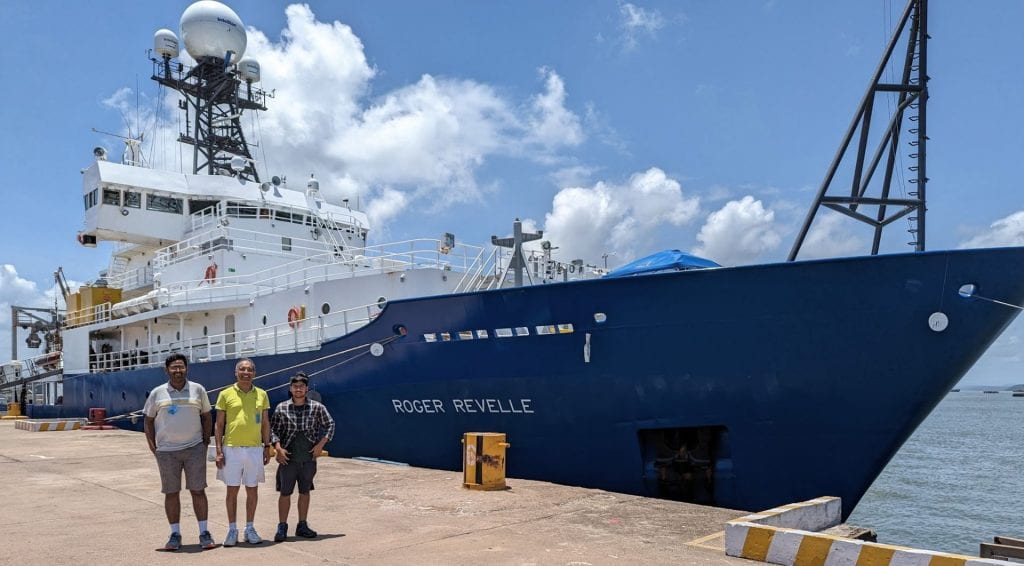
(L-R) Sid Kerhalkar, Prof. Amit Tandon and Debarshi Sarkar with the R/V Roger Revelle docked in the Mormugao port.
Professor Amit Tandon, Siddhant (Sid) Kerhalkar (PhD candidate) and Debarshi Sarkar (incoming PhD student) were aboard the US research vessel Roger Revelle for the pilot cruise of EKAMSAT (Enhancing Knowledge of the Arabian Sea Marine Environment through Science and Advanced Training) in the Arabian Sea, June 09-26, 2023. EKAMSAT is a USA-India international collaboration. The USA team is funded by the US Office of Naval Research for the air-sea interaction, marine meteorology, and physical oceanography components, and the Indian team is funded by the Indian Ministry of Earth Sciences (MoES). During the pilot, the two teams worked collaboratively to understand the evolution of the mini-warm pool in the Arabian Sea and its connection to the Indian Summer Monsoon. In addition, three NASA-funded scientists also joined this cruise to examine the ocean ecosystem during this cruise.
After reaching Goa during the first week of June, the three of them were joined onboard by 20 other scientists from institutions such as the University of Washington, Scripps Institution of Oceanography, Woods Hole Oceanographic Institution, Columbia University, University of Notre Dame, Consiglio Nazionale delle Ricerche (Italy), NOAA Center for Weather and Climate Prediction, Penn State University, Whatcom Community College and Indian institutions INCOIS, NIOT, NCMRWF, and IITM-Pune. The ship made port calls in Goa, India for this experiment, with Prof. Craig Lee from U of Washington as the chief scientist of the cruise. The ship left the Mormugao port on the night of June 08. 2023, while the Arabian sea was being churned by cyclone Biparjoy resulting in a very high wave and wind state. To commemorate the beginning of the pilot cruise and the project, the ship was virtually flagged by the MoES secretary. Due to the passage of Tropical cyclone Biparjoy, the team shifted its target station southward from 14.6 N, 69 E (NIOT AD07 mooring) to 12.06 N, 67.75 E (100 km offshore of AD 08 mooring). This meant that the ship had a longer transit time, which was made tougher due to rough waves from the cyclone, making most of the members sea-sick for the initial few days.
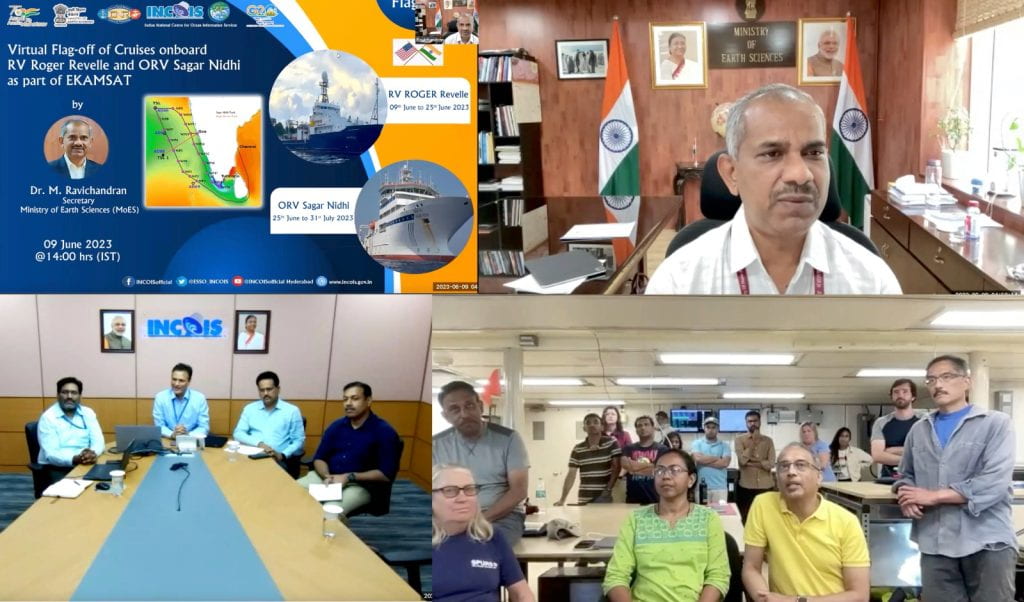
Virtual flag-off of EKAMSAT cruises (Source: INCOIS Twitter)
In addition to learning how to operate out of Goa, the scientific goals of the pilot cruise were focused on understanding the processes that governed the evolution of stratification around the target station (one-dimensional versus the lateral processes) before obtaining clean simultaneous measurements of atmospheric variables and vertical ocean profiles to measure accurate air-sea fluxes, including the importance of waves and swell for these fluxes. In order to obtain clean atmospheric measurements, the ship needs to point into the wind. The passage of the cyclone also inspired secondary goals of understanding the role of waves in driving the mixing and sampling across the cyclone wake to unearth the processes behind restratifying the cold dense wake created by the cyclone .
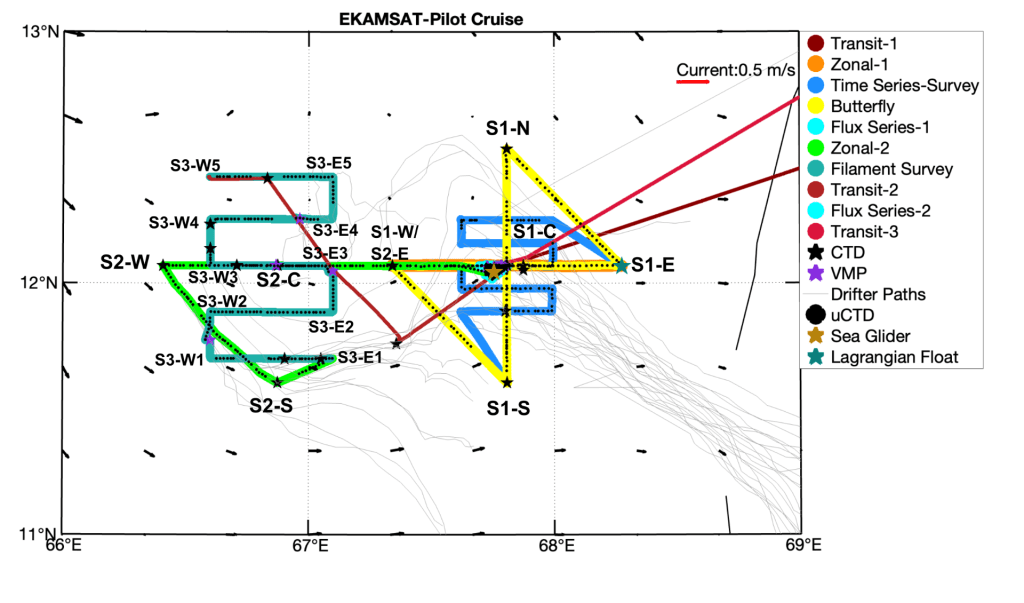
Cruise Map of EKAMSAT Pilot 2023
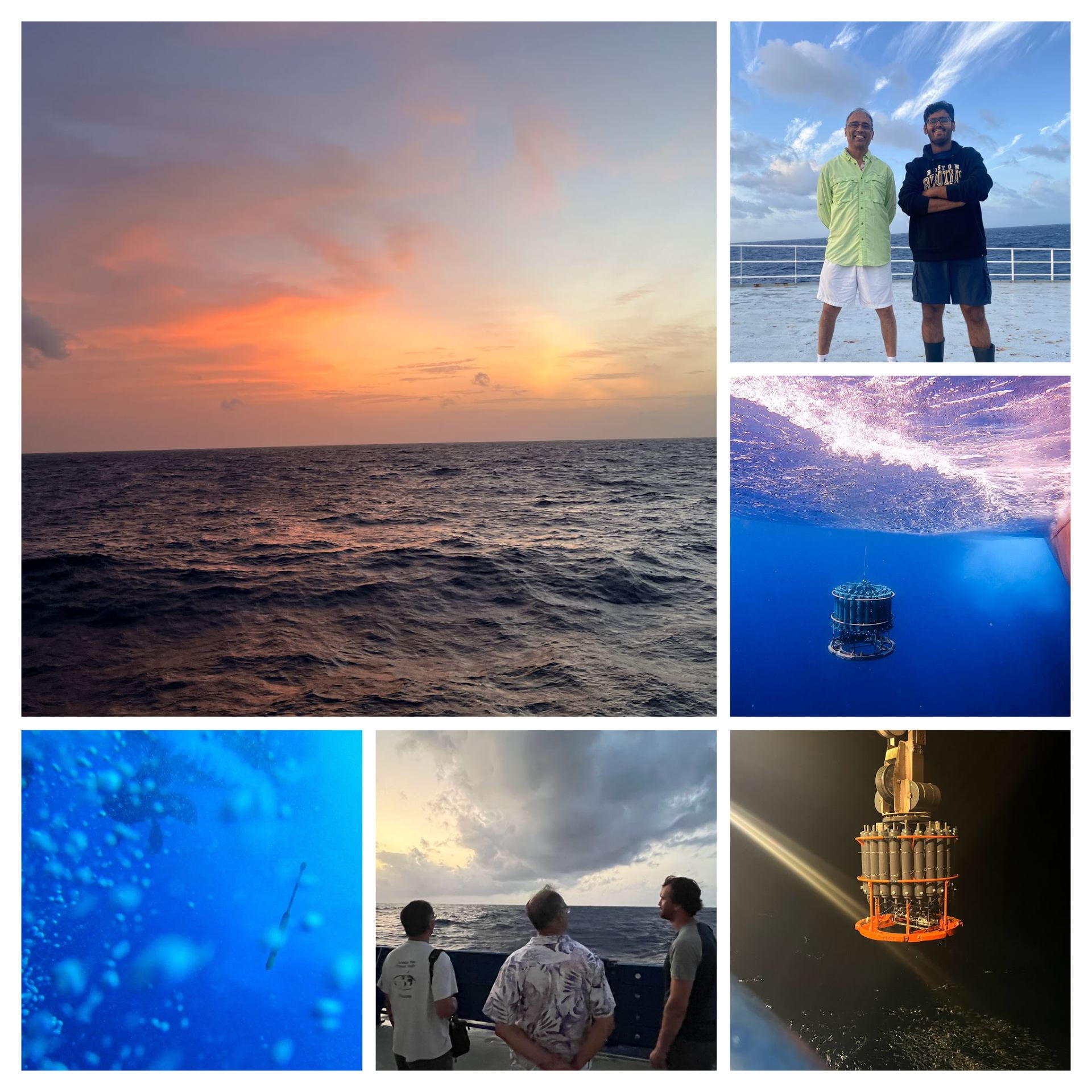
(Clockwise from Top Left): A pretty sunset in Arabian Sea, Prof Tandon and Sid during the watch, CTD rosette underwater, CTD rosette being deployed, Science discussions in the hope of a rain event, uCTD probe underwater
This cruise was a major learning experience for the participating student members of Tandon lab: Sid and Debarshi. In addition to both of them participating in uCTD watches and helping with typical deployment-recovery of other gear when needed, Sid was mostly in charge of preliminary processing and visualization of the ship through-flow, lower atmospheric variables, and wave data. Debarshi, who was participating in his first scientific cruise, was tasked to process and plot the profiles from the CTD casts. The data and ideas from this experiment will eventually be used for parts of their respective dissertations. Along with serving on watches, Professor Tandon provided overall guidance, as well as conceptual inputs to the cruise along with senior scientist Professor Janet Sprintall and Chief scientist Professor Craig Lee.
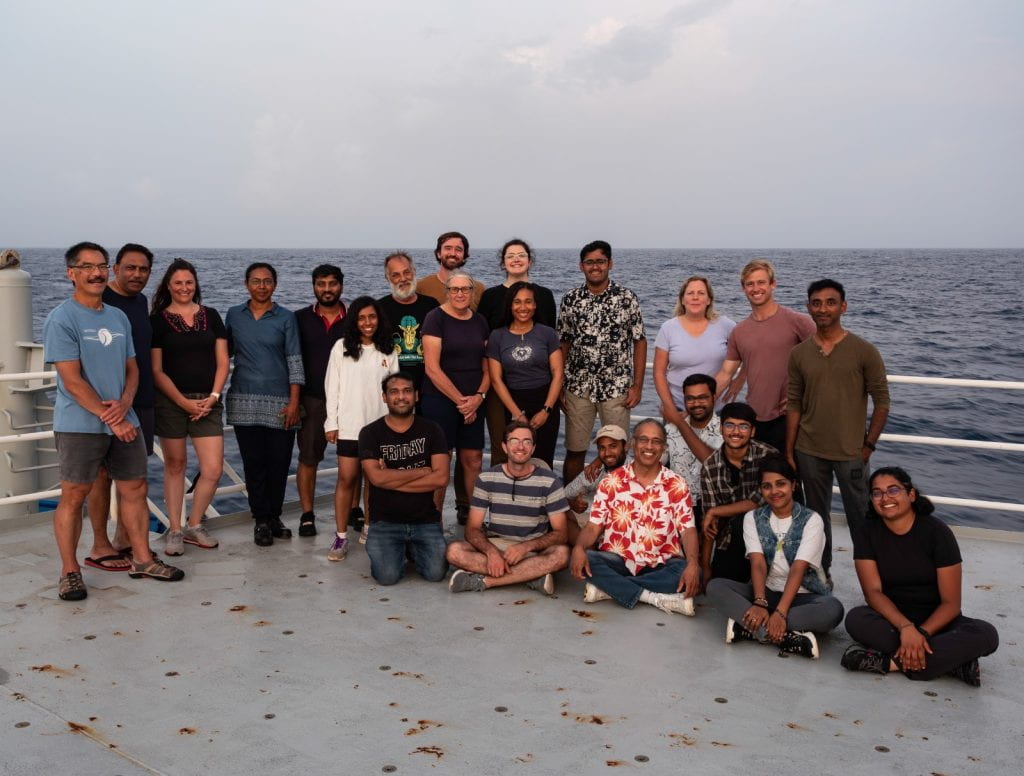
EKAMSAT Pilot Cruise 2023 Science Team
Sid also documented some of the science activities on the cruise using his action camera (see the video above). Overall, the cruise was very successful and the team members are now looking forward to analyzing the dataset and working on the science further.
Sid was recently featured in the Feature stories section of UMassD. Find more about his motivation for pursuing his doctoral dissertation in the Tandon Lab, his research interests, his participation in research cruises and his favorite things about the lab and UMassD in the article here.
Congratulations Sid!
A group of researchers including Prof. Amit Tandon have unveiled an innovative approach to studying rainfall patterns in a recent article published in the Journal of the Acoustical Society of America. By harnessing the power of Principal Component Analysis (PCA) and acoustic data using hydrophones, scientists are pushing the boundaries of detecting precipitation. Traditional methods of tracking rainfall rely on weather radar and satellite imagery, which can be limited in remote or heavily vegetated areas. Given that more than 75% of the Earth’s precipitation occurs over the ocean and satellite measurements have large uncertainties, meteorologists and climatologists seek alternate rain detection methods to further improve weather prediction models.
This paper uses data from a weather station, located in the SMAST pier in New Bedford as a reference and simultaneously listened to the rainfall from the hydrophones on the pier to develop a new PCA based rain detection algorithm which exploits broadband acoustic data.

The data collection setup in SMAST pier. The hydrophones are 1 and 2 m below the low-tide line at the end of the pier. Weather measurements occur on the pier itself.
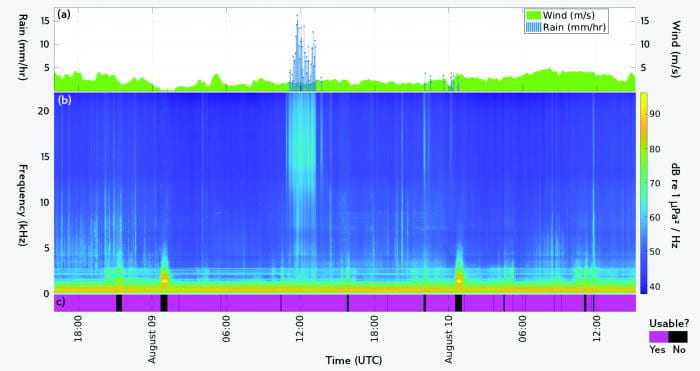
Top (a): Rain and wind recorded by the weather station for a few days in August 2021. Middle (b): A spectrogram of audio data recorded by a pier-mounted hydrophone during this time. Bottom (c): A banded plot showing whether a datapoint is usable in this experiment.
More information about this article can be found here. Congratulations Dr Mallary and team!
Siddhant (Sid) Kerhalkar, a PhD candidate in Tandon labs, presented a seminar on his research on Diurnal Warm Layers (DWLs) at Indian Institute of Tropical Meteorology Pune on July 11, 2023. Attended by many distinguished scientists there, Sid was able to convince the audience about the importance of DWLs in monsoon representation and present observational evidence of the lateral variability over O(30 km) in these layers, arguably due to the spatial gradients in the wind speed patterns and background stratification over similar length scales in the Bay of Bengal.
Sid also utilized this time to understand the work various research various groups do at IITM Pune as well as understand how observational oceanographers like him could help the modeling community in developing a better understanding of monsoons.
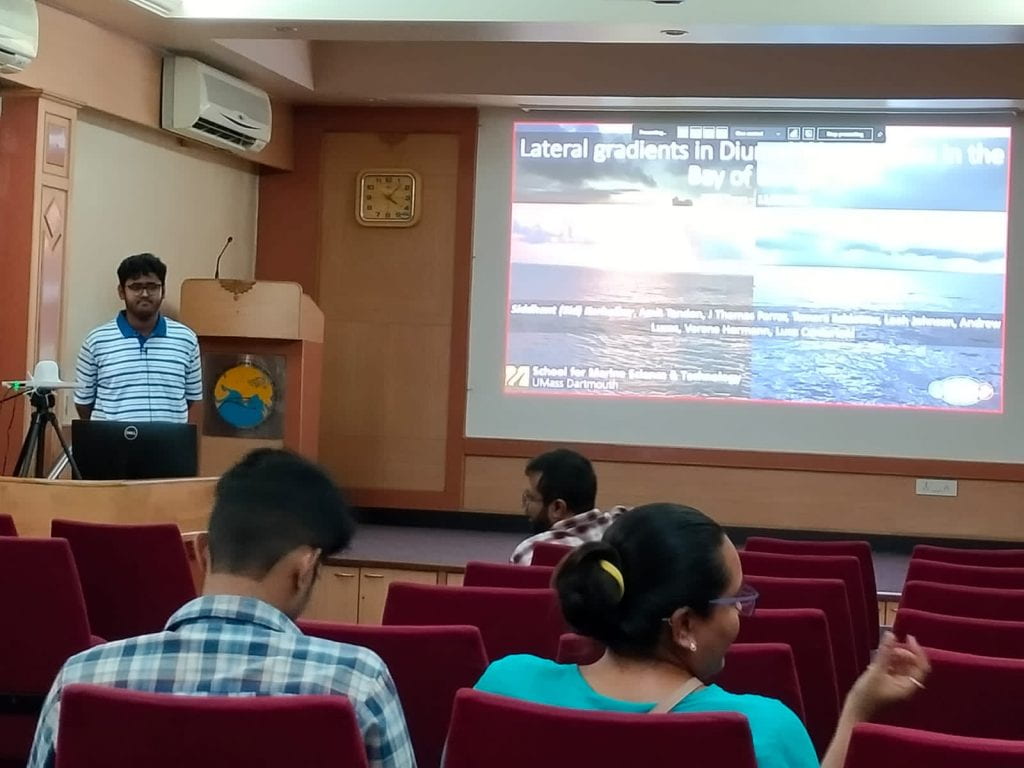
Sid presenting at IITM Pune
In an endeavor to navigate the careers in ocean research, Iury and Sid participated in the ONR Code 322 Graduate Student and Postdoc Workshop, hosted in Arlington, VA, on May 22-23, 2023. This comprehensive career workshop illuminated the diverse array of opportunities, showcased the pivotal functions of the Office of Naval Research (ONR), emphasized the art of science communication, underscored the importance of safe and inclusive fieldwork practices, and facilitated networking among peers and potential employers. This workshop was attended by various officials from U.S. Navy, ONR, NOAA, NSF, NRL etc.
This workshop helped the attendees see their research as contributing to the broader society. Moreover, the workshop’s focus on science communication resonated deeply and recognized its pivotal role in conveying the significance of their work to diverse audiences.
Finally, the networking sessions held great value as they allowed Iury and Sid to connect with potential employers and peers. These connections opened doors to opportunities, form mentorship and collaborations.
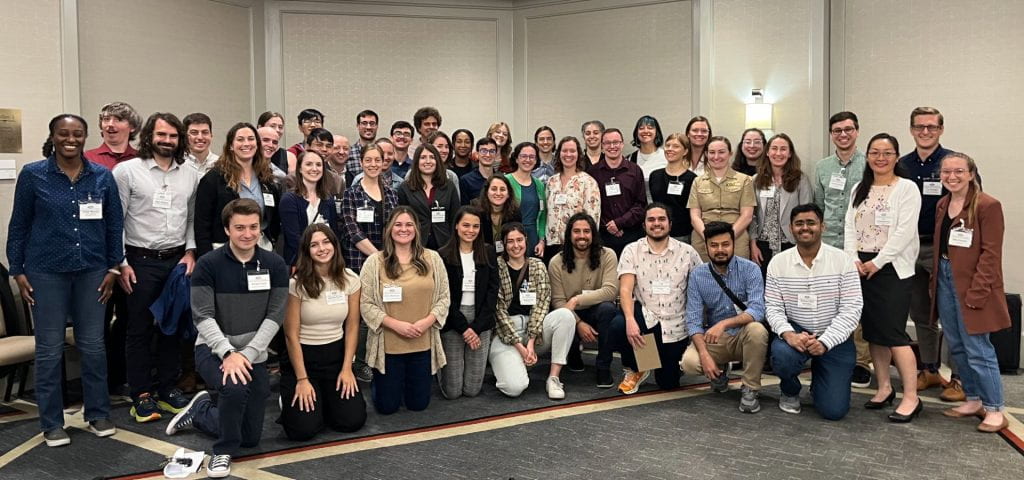
Iury and Sid participating in the ONR Code 322 Workshop
Viktoriya was recently featured in the Feature stories section of UMassD. Find more about the different avenues she pursued before doing her undergraduate thesis in the Tandon Lab, in the article here.
Congratulations Vicky!
Senior year undergraduate students, Nicholas Monroe and Viktoriya Balabanova, presented their respective research topics at recently concluded Massachusetts Undergraduate Research Conference (MassURC) on April 28, 2023. This annual conference is organized by UMass Amherst.
Nicholas, along with Sid and Prof. Tandon, presented his work on “Biases in the modeled air-sea interaction during 2017-18 in the Arabian Sea” and his talk can be accessed here. On the other hand, Viktoriya talked about “Validating Geostrophic Balances in the North Atlantic Ocean”, which was co-authored with Sid, Dr. Farrar and Prof. Tandon. Her talk can be viewed here.
Congratulations Nicholas and Viktoriya!
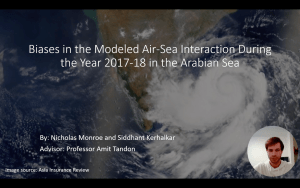
Nicholas presenting his work at MassURC
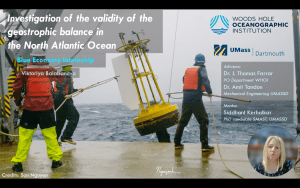
Viktoriya presenting her work at MassURC
Siddhant (Sid) Kerhalkar, a fourth year PhD candidate, recently participated and presented an invited talk on his research at the European Geophysical Union (EGU) 2023 Meeting in Vienna during April 23-28, 2023. Sid utilized the hybrid format of the meeting and presented remotely on “Observing and Modeling the variability of DWLs during the summer Monsoon in the Northern Indian Ocean” in the Ocean surface mixed layer session. This session was well attended both in-person as well as remotely.
Sid’s participation was supported by Graduate Studies Office, UMassD. Congratulations Sid!

A screenshot of Sid’s title slide
United States-India Educational Foundation (USIEF), which is responsible for Fulbright fellowships, recently interviewed Dr.Shikha Singh to share her experiences while visiting the Tandon lab as a Fulbright-Kalam Climate scholar during 2019-20. The full interview can be watched here.
Congatulations Dr. Shikha Singh!
© 2024 Exploring the upper ocean
Theme by Anders Noren — Up ↑
Recent Comments